
|
|

March 21, 2008
WQEW 1560, New York
In this week's installment of Tower Site of the Week, we finally complete our collection of the city's 50,000-watt AMs. In earlier installments of the series, we've visited WFAN/WCBS, WOR (and WOR again, and again), WABC, WINS, WEPN and WBBR.
But up at the top of the dial, at 1560, there's one more 50,000-watt signal. Today, it's Radio Disney outlet WQEW - but this venerable station has a long history that goes back to, of all things, an early experimental television station!
Early, in this case, is 1929, when John V.L. Hogan was granted an experimental license, W2XR, to transmit mechanically-scanned television pictures up in the shortwave region (2100 kHz and above). The TV experiments lasted only a few years, but in 1933 Hogan began to accompany his television images with classical music transmitted on a special "high-fidelity" AM band just above the regular broadcast band, which then ended at 1500 kilocycles.
W2XR's music broadcasts were aired over a 20 kHz-wide channel at 1550 kc, and its regular schedule, which started in 1934, soon drew an enthusiastic following among fans of high-quality music.
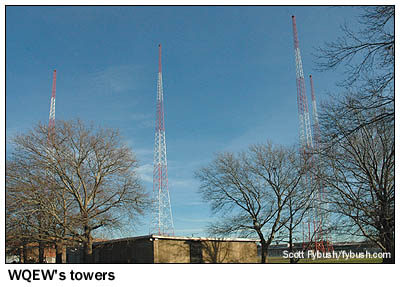 |
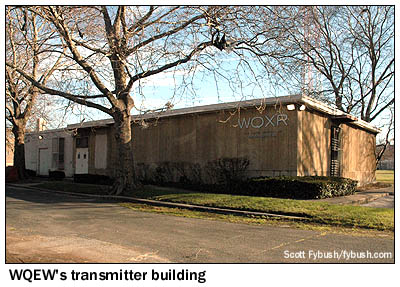 |
In 1936, experimental W2XR became commercial WQXR, operating from this very site tucked between Grand Avenue and Metropolitan Avenue in the industrial Queens neighborhood of Maspeth, just blocks from the Brooklyn line.
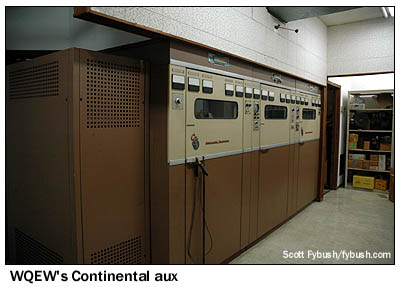 The
original 1936 transmitter building can still be seen at the left
side of the current facility. It housed a small office and a
transmitter room that contained a homebrew 10,000-watt transmitter,
feeding a single tower that still stands (at the center of the
photo above).
The
original 1936 transmitter building can still be seen at the left
side of the current facility. It housed a small office and a
transmitter room that contained a homebrew 10,000-watt transmitter,
feeding a single tower that still stands (at the center of the
photo above).
WQXR was shifted to 1560 in the big NARBA upheaval of 1941. Three years later, Sanger sold the station (and its new FM sister, WQXQ) to the New York Times, and on March 19, 1956 it boosted power to 50 kilowatts, adding the current transmitter building and two additional towers.
The antenna configuration was tweaked again in 1964, when a fourth tower was added. By day, 1560 uses two towers, switching to a three-tower array at sunset in Bakersfield, California, where it shares 1560 with KNZR (formerly KPMC).
While warehouses grew up around this site (today the building and grounds are almost invisible from any of the streets that surround it), the transmitter lineup inside the building kept changing. The initial 50-kilowatt transmitter was a Westinghouse 50HG, filling a big room at the center of the new building. It was supplanted two decades later by a Continental 317-C2 that replaced the old 10-kilowatt unit in the old transmitter building.
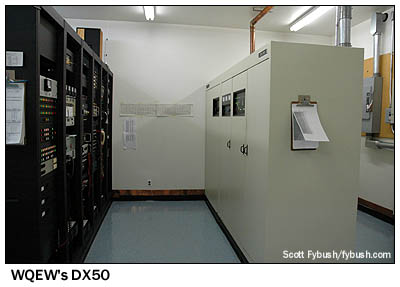
|
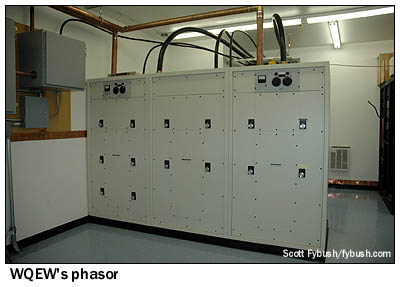
|
The Continental, in turn, was relegated to backup duty when then-chief engineer Herb Squire built a new transmitter room at the other end of the building, including a new phasor and a new Harris DX50 transmitter. The Westinghouse was removed from the center of the building, which ended up being used for storage.
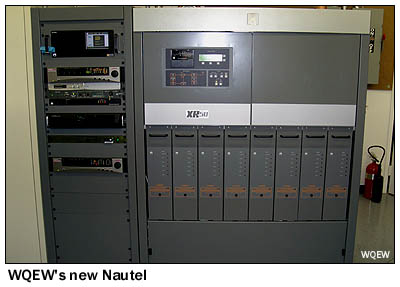 In December
1992, classical music finally disappeared from New York's AM
dial when the Times filled the void caused by the demise
of WNEW (1130), flipping WQXR(AM) to WQEW, "The Home of
American Popular Standards." It was a good six-year run,
but in 1998 the Times began leasing the station to Radio
Disney, which finally purchased WQEW outright in 2007.
In December
1992, classical music finally disappeared from New York's AM
dial when the Times filled the void caused by the demise
of WNEW (1130), flipping WQXR(AM) to WQEW, "The Home of
American Popular Standards." It was a good six-year run,
but in 1998 the Times began leasing the station to Radio
Disney, which finally purchased WQEW outright in 2007.
These pictures date from the final months of Times ownership, and there have been some changes since Disney took over, including a new Nautel transmitter to supplant the Harris, as well as the addition of HD Radio. That's the new Nautel XR50 to the left, now sitting next to the DX50. (The Continental, meanwhile, has left the building.)
And as a technicality, there's now another 50,000-watt AM in New York, now that we think of it - but never fear, we've got pictures and they'll be coming your way in a few weeks.
Tower Site Calendar 2008 is here! Visit the Fybush.com Store now and get your calendar now!
- Previous Site of the Week: WQXR, New York
- Next Week: WFUV, New York
- Site of the Week INDEX!
- How can you help support Site of the Week? Click here!
- Submit your suggestions for a future Site of the Week!
